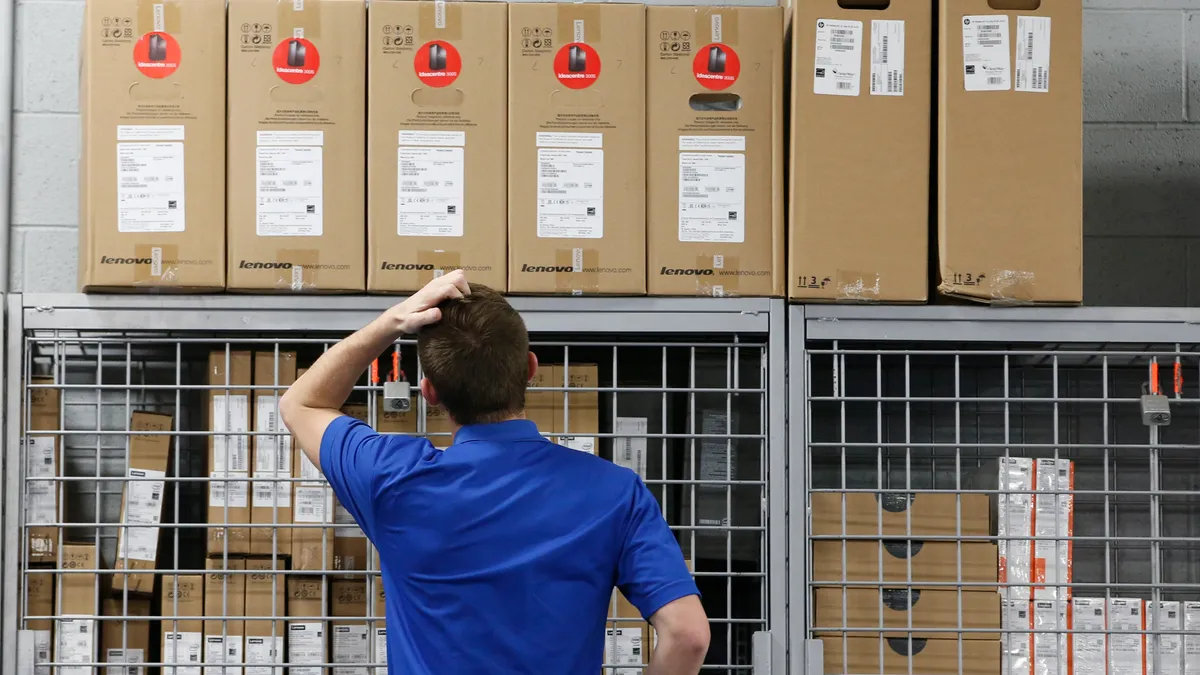Dive Brief:
- Growing sales in March were met with flat inventory growth, according to the latest figures from the Census Bureau. The inventory-to-sales ratio dropped to 1.23 in March, the lowest ever recorded.
- Manufacturers, retailers and wholesalers saw their sales grow by 9% YoY, 28% YoY and 19% YoY, respectively. Retail, with the most sales growth, is the only group that saw inventories decline in March, falling more than 7% YoY.
- Overall, business inventories declined by 1% YoY, while sales grew almost 20% YoY. Comparing anything to the beginning of the pandemic is tricky, but these differences extend to 2019. Inventories have fallen by less than 1% while sales are up 12% compared to March 2019.
Flat inventories and high sales lead to record-low ratio in March
Dive Insight:
Inventory woes have been a staple of recent earnings calls, on which executives discuss steps they're taking to build stock.
Walmart has started to lengthen its lead times, while Yeti and other companies have turned to alternative ports in an effort to avoid the congestion that has slowed operations at some West Coast facilities.
The current environment highlights just how much a company's internal operations and inventory planning rely on a smoothly run freight environment. And the freight environment has been rocky for more than a year.
These supply chain issues, combined with high consumer demand, have affected available inventories, according to Jon Gold, National Retail Federation's vice president of supply chain and customs policy.
"The ability to get products from overseas certainly has been a challenge," Gold said. "Not just from the factories' ability to keep up and produce what's needed, but the ability to find empty containers and get the product into a container and then onto a vessel and then facing the congestion delays we're facing here at U.S. ports."
Gold said some retailers are taking steps similar to Walmart and building in extra days into their shipping schedules to improve their inventory planning. And these changes are happening as retailers prepare for back-to-school and holiday seasons.
"The peak shipping season for the holidays typically begins in August," he said. "And for a lot of different folks, they're looking at moving that up because of the ongoing disruption issues that they're seeing."
Many onlookers over the past year have been quick to point out that lean inventories and just-in-time philosophies helped to create this issue of stockouts. A Tuesday report in The New York Times highlighted that the trend of lower inventories has created savings that have largely gone into share buybacks.
Supply chains are truly divided on how to move forward from here. A recent survey from Gartner found that 44% of supply chain professionals have plans to invest in increased inventory over the next two years, while 46% have no such plans.
The lean philosophies have created issues for automakers this year as the industry has struggled with chip inventories, even having to cut production as a result. But the auto industry seems to be using this as a chance to double down on its just-in-time ideas, rather than pivot to bigger inventories. Ford CFO John Lawler said earlier this year that a supply chain revamp will allow dealerships to hold smaller inventories while instead using an ordering process for purchases. General Motors made similar comments last month.
Gold said companies are increasingly investing in analytics tools and talent to better predict demand and improve inventory management. Increasing inventories might be a harder sell.
"I think lean is still the way to go," he said.
This story was first published in our weekly newsletter, Supply Chain Dive: Operations. Sign up here.














